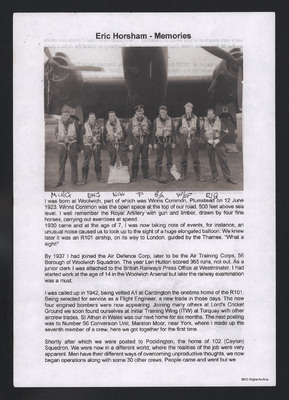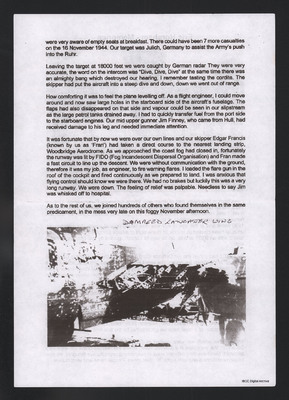Eric Horsham - Memories
Title
Eric Horsham - Memories
Description
Brief recollection of Eric Horsham from his early years in Plumstead, training at Lords, Torquay, St Athans, Marston Moor then 102 Squadron at Pocklngton. On one operation they were badly damaged but made a successful forced landing at RAF Woodbridge, assisted by FIDO. Included are two photographs, one of his crew in front of a Halifax and another of the damage sustained to the 'Lancaster's' wing (actually a Halifax).
Creator
Spatial Coverage
Language
Format
Two typewritten sheets
Publisher
Rights
This content is available under a CC BY-NC 4.0 International license (Creative Commons Attribution-NonCommercial 4.0). It has been published ‘as is’ and may contain inaccuracies or culturally inappropriate references that do not necessarily reflect the official policy or position of the University of Lincoln or the International Bomber Command Centre. For more information, visit https://creativecommons.org/licenses/by-nc/4.0/ and https://ibccdigitalarchive.lincoln.ac.uk/omeka/legal.
Contributor
Identifier
BHorshamESHorshamESv10001,
BHorshamESHorshamESv10002
BHorshamESHorshamESv10002
Transcription
Eric Horsham - Memories
[photograph]
[inserted] MU/G ENG NAV P B/A W/OP R/G [/inserted]
I was born at Woolwich, part of which was Winns Common, Plumstead on 12 June 1923. Winns Common was the open space at the top of our road, 500 feet above sea level. I well remember the Royal Artillery with gun and limber, drawn by four fine horses, carrying out exercises at speed.
1930 came and at the age of 7, I was now taking note of events, for instance, an unusual noise caused us to look up to the sight of a huge elongated balloon. We knew later it was an R101 airship, on its way to London, guided by the Thames. “What a sight!”
By 1937 I had joined the Air Defence Corp, later to be the Air Training Corps, 56 Borough of Woolwich Squadron. The year Len Hutton scored 365 runs, not out. As a junior clerk I was attached to the British Railways Press Office at Westminster. I had started work at the age of 14 in the Woolwich Arsenal but later the railway examination was a must.
I was called up in 1942, being vetted A1 at Cardington the onetime home of the R101. Being selected for service as a Flight Engineer, a new trade in those days. The new four engine bombers were now appearing. Joining many others at Lord’s Cricket Ground we soon found ourselves at Initial Training Wing (ITW) at Torquay with other aircrew trades. St Athan in Wales was our next home for six months. The next posting was to Number 56 Conversion Unit, Marston Moor, near York, where I made up the seventh member of a crew, here we got together for the first time.
Shortly after which we were posted to Pocklington, the home of 102 (Ceylon) Squadron. We were now in a different world, where the realities of the job were very apparent. Men have their different ways of overcoming unproductive thoughts, we now began operations along with some 30 other crews. People came and went but we
[page break]
were very aware of empty seats at breakfast. There could have been 7 more casualties on the 16 November 1944. Our target was Julich, Germany to assist the Army’s push into the Ruhr.
Leaving the target at 18000 feet we were caught by German radar They were very accurate, the word on the intercom was “Dive, Dive, Dive” at the same time there was an almighty bang which destroyed our hearing, I remember tasting the cordite. The skipper had put the aircraft into a steep dive and down, down we went out of range.
How comforting it was to feel the plane levelling off. As a flight engineer, I could move around and now saw large holes in the starboard side of the aircraft’s fuselage. The flaps had also disappeared on that side and vapour could be seen in our slipstream as the large petrol tanks drained away. I had to quickly transfer fuel from the port side to the starboard engines. Our mid upper gunner Jim Finney, who came from Hull, had received damage to his leg and needed immediate attention.
It was fortunate that by now we were over our own lines and our skipper Edgar Francis (known to us as ‘Fran’) had taken a direct course to the nearest landing strip, Woodbridge Aerodrome. As we approached the coast fog had closed in, fortunately the runway was lit by FIDO (Fog Incandescent Dispersal Organisation) and Fran made a fast circuit to line up the descent. We were without communication with the ground, therefore it was my job, as engineer, to fire warning flares. I loaded the flare gun in the roof of the cockpit and fired continuously as we prepared to land. I was anxious that flying control should know we were there. We had no brakes but luckily this was a very long runway. We were down. The feeling of relief was palpable. Needless to say Jim was whisked off to hospital.
As to the rest of us, we joined hundreds of others who found themselves in the same predicament, in the mess very late on this foggy November afternoon.
[inserted] DAMAGED LANCASTER WING [/inserted]
[photograph]
[photograph]
[inserted] MU/G ENG NAV P B/A W/OP R/G [/inserted]
I was born at Woolwich, part of which was Winns Common, Plumstead on 12 June 1923. Winns Common was the open space at the top of our road, 500 feet above sea level. I well remember the Royal Artillery with gun and limber, drawn by four fine horses, carrying out exercises at speed.
1930 came and at the age of 7, I was now taking note of events, for instance, an unusual noise caused us to look up to the sight of a huge elongated balloon. We knew later it was an R101 airship, on its way to London, guided by the Thames. “What a sight!”
By 1937 I had joined the Air Defence Corp, later to be the Air Training Corps, 56 Borough of Woolwich Squadron. The year Len Hutton scored 365 runs, not out. As a junior clerk I was attached to the British Railways Press Office at Westminster. I had started work at the age of 14 in the Woolwich Arsenal but later the railway examination was a must.
I was called up in 1942, being vetted A1 at Cardington the onetime home of the R101. Being selected for service as a Flight Engineer, a new trade in those days. The new four engine bombers were now appearing. Joining many others at Lord’s Cricket Ground we soon found ourselves at Initial Training Wing (ITW) at Torquay with other aircrew trades. St Athan in Wales was our next home for six months. The next posting was to Number 56 Conversion Unit, Marston Moor, near York, where I made up the seventh member of a crew, here we got together for the first time.
Shortly after which we were posted to Pocklington, the home of 102 (Ceylon) Squadron. We were now in a different world, where the realities of the job were very apparent. Men have their different ways of overcoming unproductive thoughts, we now began operations along with some 30 other crews. People came and went but we
[page break]
were very aware of empty seats at breakfast. There could have been 7 more casualties on the 16 November 1944. Our target was Julich, Germany to assist the Army’s push into the Ruhr.
Leaving the target at 18000 feet we were caught by German radar They were very accurate, the word on the intercom was “Dive, Dive, Dive” at the same time there was an almighty bang which destroyed our hearing, I remember tasting the cordite. The skipper had put the aircraft into a steep dive and down, down we went out of range.
How comforting it was to feel the plane levelling off. As a flight engineer, I could move around and now saw large holes in the starboard side of the aircraft’s fuselage. The flaps had also disappeared on that side and vapour could be seen in our slipstream as the large petrol tanks drained away. I had to quickly transfer fuel from the port side to the starboard engines. Our mid upper gunner Jim Finney, who came from Hull, had received damage to his leg and needed immediate attention.
It was fortunate that by now we were over our own lines and our skipper Edgar Francis (known to us as ‘Fran’) had taken a direct course to the nearest landing strip, Woodbridge Aerodrome. As we approached the coast fog had closed in, fortunately the runway was lit by FIDO (Fog Incandescent Dispersal Organisation) and Fran made a fast circuit to line up the descent. We were without communication with the ground, therefore it was my job, as engineer, to fire warning flares. I loaded the flare gun in the roof of the cockpit and fired continuously as we prepared to land. I was anxious that flying control should know we were there. We had no brakes but luckily this was a very long runway. We were down. The feeling of relief was palpable. Needless to say Jim was whisked off to hospital.
As to the rest of us, we joined hundreds of others who found themselves in the same predicament, in the mess very late on this foggy November afternoon.
[inserted] DAMAGED LANCASTER WING [/inserted]
[photograph]
Collection
Citation
Eric Horsham, “Eric Horsham - Memories,” IBCC Digital Archive, accessed July 26, 2024, https://ibccdigitalarchive.lincoln.ac.uk/omeka/collections/document/17768.
Item Relations
This item has no relations.


